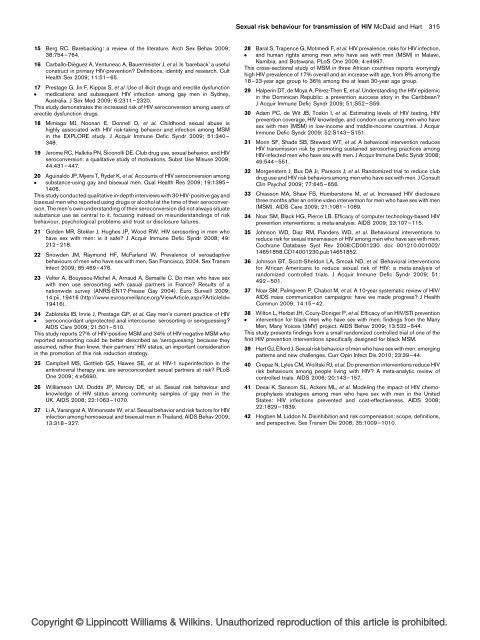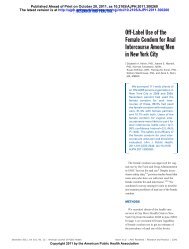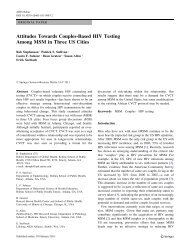314 <strong>Sexual</strong> <strong>transmission</strong> <strong>of</strong> <strong>HIV</strong>and <strong>for</strong> MSM <strong>in</strong> LMIC [35]. However, one recent USevaluation <strong>of</strong> an <strong>HIV</strong> prevention <strong>in</strong>tervention <strong>for</strong> blackMSM reported positive reductions <strong>in</strong> UAI with casualpartners [38 ], and Johnson et al. [36] reported <strong>in</strong>creased<strong>in</strong>tervention effectiveness on condom use <strong>in</strong> the studiesthat <strong>in</strong>cluded a greater proportion <strong>of</strong> MSM <strong>in</strong> their samples<strong>in</strong> their meta-analysis <strong>of</strong> <strong>behaviour</strong>al <strong>in</strong>terventions <strong>for</strong>African–Americans. Further trials, which <strong>in</strong>clude biologicalendpo<strong>in</strong>ts, are required. Behavioural <strong>in</strong>terventionsshould also target those most at <strong>risk</strong> <strong>of</strong> <strong>HIV</strong> <strong>transmission</strong>and <strong>in</strong> the sett<strong>in</strong>gs <strong>in</strong> which <strong>risk</strong> <strong>behaviour</strong> occurs.ConclusionIncreas<strong>in</strong>g <strong>sex</strong>ual <strong>risk</strong> <strong>behaviour</strong> and <strong>HIV</strong> <strong>transmission</strong>among MSM is apparent, although <strong>risk</strong> reduction strategiessuch as serosort<strong>in</strong>g and strategic position<strong>in</strong>g arebe<strong>in</strong>g reported more <strong>of</strong>ten. However, their efficacy isquestionable, particularly when knowledge <strong>of</strong> <strong>HIV</strong> statusmay be <strong>in</strong>accurate. The <strong>risk</strong> <strong>for</strong> <strong>HIV</strong> <strong>transmission</strong> amongMSM <strong>in</strong> LMIC, and the role <strong>of</strong> MSM <strong>in</strong> the <strong>HIV</strong>epidemics <strong>of</strong> these countries, is <strong>of</strong> special concern,particularly when <strong>HIV</strong> prevalence among AfricanMSM is reportedly higher than among the adult malegeneral population.These f<strong>in</strong>d<strong>in</strong>gs should <strong>in</strong><strong>for</strong>m future <strong>HIV</strong> preventionef<strong>for</strong>ts and evidence <strong>of</strong> effective <strong>behaviour</strong>al <strong>in</strong>terventionsis grow<strong>in</strong>g. Nonetheless, <strong>behaviour</strong> change alone isunlikely to result <strong>in</strong> the susta<strong>in</strong>ed reductions <strong>in</strong> <strong>HIV</strong><strong>transmission</strong> necessary to change the course <strong>of</strong> the<strong>HIV</strong> epidemic, and it has been argued that ‘comb<strong>in</strong>ationprevention’, which <strong>in</strong>corporates biomedical and <strong>behaviour</strong>al,as well as social and structural, <strong>in</strong>terventionsshould be the way <strong>for</strong>ward [2]. In terms <strong>of</strong> address<strong>in</strong>g<strong>transmission</strong> <strong>of</strong> <strong>HIV</strong>, this may be particularly appropriate<strong>for</strong> <strong>HIV</strong>-positive MSM [39]; to date, few exclusively<strong>behaviour</strong>al <strong>in</strong>terventions with <strong>HIV</strong>-positive MSM <strong>have</strong>been demonstrated to be effective [40]. In relation to theacquisition <strong>of</strong> <strong>HIV</strong> <strong>in</strong> MSM, one study has estimated thatall that is required to <strong>of</strong>fset the number <strong>of</strong> <strong>HIV</strong> <strong>in</strong>fectionspotentially prevented by use <strong>of</strong> preexposure chemoprophylaxisis a small (4%) <strong>in</strong>crease <strong>in</strong> the annual number <strong>of</strong>new <strong>sex</strong>ual partners [41].Biomedical <strong>in</strong>terventions necessarily <strong>in</strong>clude <strong>behaviour</strong>alcomponents (<strong>in</strong><strong>for</strong>mation, education, community mobilizationand adherence to regi<strong>men</strong>s and/or recom<strong>men</strong>ded<strong>risk</strong> reduction), and this is particularly important if we areto counter possible dis<strong>in</strong>hibition and <strong>risk</strong> compensation[42]. There rema<strong>in</strong>s an urgent need <strong>in</strong> an era <strong>of</strong> highlyeffective and successful antiretroviral treat<strong>men</strong>t to identifysuccessful <strong>HIV</strong> prevention <strong>in</strong>terventions, to keep <strong>HIV</strong>negativeMSM negative, prevent<strong>in</strong>g acquisition, and tosupport and strengthen <strong>HIV</strong>-positive <strong>men</strong>’s resolve not topass on <strong>HIV</strong> <strong>in</strong>fection, and <strong>in</strong> so do<strong>in</strong>g halt <strong>transmission</strong>.Acknowledge<strong>men</strong>tsThe UK Medical Research Council funds Dr L.M.McD. as part <strong>of</strong> the<strong>Sexual</strong> and Reproductive Health Programme (WBS U.1300.00.005) atthe Social and Public Health Sciences Unit.References and recom<strong>men</strong>ded read<strong>in</strong>gPapers <strong>of</strong> particular <strong>in</strong>terest, published with<strong>in</strong> the annual period <strong>of</strong> review, <strong>have</strong>been highlighted as: <strong>of</strong> special <strong>in</strong>terest <strong>of</strong> outstand<strong>in</strong>g <strong>in</strong>terestAdditional references related to this topic can also be found <strong>in</strong> the CurrentWorld Literature section <strong>in</strong> this issue (p. 352).1 Padian NS, Buvé A, Balkus J, et al. Biomedical <strong>in</strong>terventions to prevent <strong>HIV</strong><strong>in</strong>fection: evidence, challenges, and way <strong>for</strong>ward. Lancet 2008; 372:585–599.2 Coates TJ, Richter L, Caceres C. Behavioural strategies to reduce <strong>HIV</strong><strong>transmission</strong>: how to make them work better. Lancet 2008; 372:669–684.3 UNAIDS. AIDS epidemic update: December 2009. Geneva: UNAIDS; 2009.4 Merson MH, O’Malley J, Serwadda D, Apisuk C. The history and challenge <strong>of</strong><strong>HIV</strong> prevention. Lancet 2008; 372:475–488.5Sullivan PS, Hamouda O, Delpech V, et al. Reemergence <strong>of</strong> the <strong>HIV</strong> epidemicamong <strong>men</strong> <strong>who</strong> <strong>have</strong> <strong>sex</strong> with <strong>men</strong> <strong>in</strong> North America, western Europe, andAustralia. Ann Epidemiol 2009; 19:423–431.This study presents trends <strong>in</strong> <strong>HIV</strong> and syphilis diagnoses and relatively consistentpatterns <strong>of</strong> change <strong>in</strong> MSM <strong>in</strong> eight countries (Australia, Canada, France,Germany, The Netherlands, Spa<strong>in</strong>, the UK and the USA).6 El<strong>for</strong>d J. Chang<strong>in</strong>g patterns <strong>of</strong> <strong>sex</strong>ual <strong>behaviour</strong> <strong>in</strong> the era <strong>of</strong> highly activeantiretroviral therapy. Curr Op<strong>in</strong> Infect Dis 2006; 19:26–32.7 Bozicevic I, Vonc<strong>in</strong>a L, Zigrovic L, et al. <strong>HIV</strong> epidemics among <strong>men</strong> <strong>who</strong> <strong>have</strong><strong>sex</strong> with <strong>men</strong> <strong>in</strong> central and eastern Europe. Sex Transm Infect 2009;85:336–342.8 Smith AD, Tapsoba P, Peshu N, et al. Men <strong>who</strong> <strong>have</strong> <strong>sex</strong> with <strong>men</strong> and <strong>HIV</strong>/ AIDS <strong>in</strong> sub-Saharan Africa. Lancet 2009; 374:416–422.This study highlights the grow<strong>in</strong>g evidence <strong>for</strong> the existence <strong>of</strong> MSM populations <strong>in</strong>Africa and high rates <strong>of</strong> <strong>HIV</strong> <strong>in</strong>fection among these.9 Stall R, Duran L, Wisniewski SR, et al. Runn<strong>in</strong>g <strong>in</strong> place: implications <strong>of</strong> <strong>HIV</strong><strong>in</strong>cidence estimates among urban <strong>men</strong> <strong>who</strong> <strong>have</strong> <strong>sex</strong> with <strong>men</strong> <strong>in</strong> the UnitedStates and other <strong>in</strong>dustrialized countries. AIDS Behav 2009; 13:615–629.10 Dougan S, El<strong>for</strong>d J, Chadborn TR, et al. Does the recent <strong>in</strong>crease <strong>in</strong> <strong>HIV</strong>diagnoses among <strong>men</strong> <strong>who</strong> <strong>have</strong> <strong>sex</strong> with <strong>men</strong> <strong>in</strong> the UK reflect a <strong>risk</strong> <strong>in</strong> <strong>HIV</strong><strong>in</strong>cidence or <strong>in</strong>creased uptake <strong>of</strong> <strong>HIV</strong> test<strong>in</strong>g? Sex Transm Infect 2007;83:120–126.11Crepaz N, Marks G, Liau A, et al. Prevalence <strong>of</strong> unprotected anal <strong>in</strong>tercourseamong <strong>HIV</strong>-diagnosed MSM <strong>in</strong> the United States: a meta-analysis. AIDS2009; 23:1617–1629.This systematic review <strong>of</strong> 30 studies provides a comprehensive meta-analysis onthe prevalence <strong>of</strong> UAI among 18 121 <strong>HIV</strong>-diagnosed MSM <strong>in</strong> the USA. Althoughmost practised ‘safer <strong>sex</strong>’, 26% had UAI with a partner <strong>of</strong> unknown or discordantserostatus.12J<strong>in</strong> F, Craw<strong>for</strong>d J, Prestage GP, et al. Unprotected anal <strong>in</strong>tercourse, <strong>risk</strong>reduction <strong>behaviour</strong>s, and subsequent <strong>HIV</strong> <strong>in</strong>fection <strong>in</strong> a cohort <strong>of</strong> homo<strong>sex</strong>ual<strong>men</strong>. AIDS 2009; 23:243–252.This study used data from a prospective cohort study <strong>of</strong> <strong>HIV</strong>-negative gay <strong>men</strong> <strong>in</strong>Australia to assess the <strong>risk</strong> <strong>of</strong> <strong>HIV</strong> acquisition associated with <strong>risk</strong> reductionstrategies. Compared with no UAI, the <strong>risk</strong> <strong>of</strong> <strong>HIV</strong> <strong>in</strong>fection was not higher <strong>for</strong>negotiated safety or strategic position<strong>in</strong>g, but was three times higher <strong>for</strong> serosort<strong>in</strong>gand five times higher <strong>for</strong> withdrawal.13Sullivan PS, Salazar L, Buchb<strong>in</strong>der S, Sanchez TH. Estimat<strong>in</strong>g the proportion<strong>of</strong> <strong>HIV</strong> <strong>transmission</strong>s from ma<strong>in</strong> <strong>sex</strong> partners among <strong>men</strong> <strong>who</strong> <strong>have</strong> <strong>sex</strong> with<strong>men</strong> <strong>in</strong> five US cities. AIDS 2009; 23:1153–1162.This study estimated <strong>HIV</strong> <strong>transmission</strong>s by partner (ma<strong>in</strong> or casual) and <strong>sex</strong>(receptive anal <strong>in</strong>tercourse, <strong>in</strong>sertive anal <strong>in</strong>tercourse or oral <strong>sex</strong>) types us<strong>in</strong>g datafrom MSM <strong>in</strong> five US cities and found 68% to be from ma<strong>in</strong> rather than casualpartners because <strong>of</strong> a greater frequency <strong>of</strong> <strong>sex</strong> acts and receptive anal <strong>in</strong>tercourse,and lower levels <strong>of</strong> condom use. This has important implications <strong>for</strong> <strong>HIV</strong> preventionand <strong>in</strong>tervention plann<strong>in</strong>g.14Ostrow DG, Plankey MW, Cox C, et al. Specific <strong>sex</strong> drug comb<strong>in</strong>ationscontribute to the majority <strong>of</strong> recent <strong>HIV</strong> seroconversions among MSM <strong>in</strong> theMACS. J Acquir Immune Defic Syndr 2009; 51:349–355.This study demonstrates the <strong>in</strong>creased <strong>risk</strong> <strong>of</strong> <strong>HIV</strong> seroconversion among users <strong>of</strong>poppers, stimulants and erectile dysfunction drugs.Copyright © Lipp<strong>in</strong>cott Williams & Wilk<strong>in</strong>s. Unauthorized reproduction <strong>of</strong> this article is prohibited.
<strong>Sexual</strong> <strong>risk</strong> <strong>behaviour</strong> <strong>for</strong> <strong>transmission</strong> <strong>of</strong> <strong>HIV</strong> McDaid and Hart 31515 Berg RC. Bareback<strong>in</strong>g: a review <strong>of</strong> the literature. Arch Sex Behav 2009;38:754–764.16 Carballo-Diéguez A, Ventuneac A, Bauermeister J, et al. Is ’bareback’ a usefulconstruct <strong>in</strong> primary <strong>HIV</strong>-prevention? Def<strong>in</strong>itions, identity and research. CultHealth Sex 2009; 11:51–65.17Prestage G, J<strong>in</strong> F, Kippax S, et al. Use <strong>of</strong> illicit drugs and erectile dysfunctionmedications and subsequent <strong>HIV</strong> <strong>in</strong>fection among gay <strong>men</strong> <strong>in</strong> Sydney,Australia. J Sex Med 2009; 6:2311–2320.This study demonstrates the <strong>in</strong>creased <strong>risk</strong> <strong>of</strong> <strong>HIV</strong> seroconversion among users <strong>of</strong>erectile dysfunction drugs.18 Mimiaga MJ, Noonan E, Donnell D, et al. Childhood <strong>sex</strong>ual abuse ishighly associated with <strong>HIV</strong> <strong>risk</strong>-tak<strong>in</strong>g behavior and <strong>in</strong>fection among MSM<strong>in</strong> the EXPLORE study. J Acquir Immune Defic Syndr 2009; 51:340–348.19 Jerome RC, Halkitis PN, Siconolfi DE. Club drug use, <strong>sex</strong>ual behavior, and <strong>HIV</strong>seroconversion: a qualitative study <strong>of</strong> motivations. Subst Use Misuse 2009;44:431–447.20Agu<strong>in</strong>aldo JP, Myers T, Ryder K, et al. Accounts <strong>of</strong> <strong>HIV</strong> seroconversion amongsubstance-us<strong>in</strong>g gay and bi<strong>sex</strong>ual <strong>men</strong>. Qual Health Res 2009; 19:1395–1406.This study conducted qualitative <strong>in</strong>-depth <strong>in</strong>terviews with 30 <strong>HIV</strong>-positive gay andbi<strong>sex</strong>ual <strong>men</strong> <strong>who</strong> reported us<strong>in</strong>g drugs or alcohol at the time <strong>of</strong> their seroconversion.The <strong>men</strong>’s own understand<strong>in</strong>g <strong>of</strong> their seroconversion did not always situatesubstance use as central to it, focus<strong>in</strong>g <strong>in</strong>stead on misunderstand<strong>in</strong>gs <strong>of</strong> <strong>risk</strong><strong>behaviour</strong>, psychological problems and trust or disclosure failures.21 Golden MR, Stekler J, Hughes JP, Wood RW. <strong>HIV</strong> serosort<strong>in</strong>g <strong>in</strong> <strong>men</strong> <strong>who</strong><strong>have</strong> <strong>sex</strong> with <strong>men</strong>: is it safe? J Acquir Immune Defic Syndr 2008; 49:212–218.22 Snowden JM, Raymond HF, McFarland W. Prevalence <strong>of</strong> seroadaptive<strong>behaviour</strong>s <strong>of</strong> <strong>men</strong> <strong>who</strong> <strong>have</strong> <strong>sex</strong> with <strong>men</strong>, San Francisco, 2004. Sex TransmInfect 2009; 85:469–476.23 Velter A, Bouyssou-Michel A, Arnaud A, Semaille C. Do <strong>men</strong> <strong>who</strong> <strong>have</strong> <strong>sex</strong>with <strong>men</strong> use serosort<strong>in</strong>g with casual partners <strong>in</strong> France? Results <strong>of</strong> anationwide survey (ANRS-EN17-Presse Gay 2004). Euro Surveill 2009;14:pii, 19416 (http://www.eurosurveillance.org/ViewArticle.aspx?ArticleId=19416).24Zablotska IB, Imrie J, Prestage GP, et al. Gay <strong>men</strong>’s current practice <strong>of</strong> <strong>HIV</strong>seroconcordant unprotected anal <strong>in</strong>tercourse: serosort<strong>in</strong>g or seroguess<strong>in</strong>g?AIDS Care 2009; 21:501–510.This study reports 27% <strong>of</strong> <strong>HIV</strong>-positive MSM and 34% <strong>of</strong> <strong>HIV</strong>-negative MSM <strong>who</strong>reported serosort<strong>in</strong>g could be better described as ‘seroguess<strong>in</strong>g’ because theyassumed, rather than knew, their partners’ <strong>HIV</strong> status, an important consideration<strong>in</strong> the promotion <strong>of</strong> this <strong>risk</strong> reduction strategy.25 Campbell MS, Gottlieb GS, Hawes SE, et al. <strong>HIV</strong>-1 super<strong>in</strong>fection <strong>in</strong> theantiretroviral therapy era: are seroconcordant <strong>sex</strong>ual partners at <strong>risk</strong>? PLoSOne 2009; 4:e5690.26 Williamson LM, Dodds JP, Mercey DE, et al. <strong>Sexual</strong> <strong>risk</strong> <strong>behaviour</strong> andknowledge <strong>of</strong> <strong>HIV</strong> status among community samples <strong>of</strong> gay <strong>men</strong> <strong>in</strong> theUK. AIDS 2008; 22:1063–1070.27 Li A, Varangrat A, Wimonsate W, et al. <strong>Sexual</strong> behavior and <strong>risk</strong> factors <strong>for</strong> <strong>HIV</strong><strong>in</strong>fection among homo<strong>sex</strong>ual and bi<strong>sex</strong>ual <strong>men</strong> <strong>in</strong> Thailand. AIDS Behav 2009;13:318–327.28Baral S, Trapence G, Motimedi F, et al. <strong>HIV</strong> prevalence, <strong>risk</strong>s <strong>for</strong> <strong>HIV</strong> <strong>in</strong>fection,and human rights among <strong>men</strong> <strong>who</strong> <strong>have</strong> <strong>sex</strong> with <strong>men</strong> (MSM) <strong>in</strong> Malawi,Namibia, and Botswana. PLoS One 2009; 4:e4997.This cross-sectional study <strong>of</strong> MSM <strong>in</strong> three African countries reports worry<strong>in</strong>glyhigh <strong>HIV</strong> prevalence <strong>of</strong> 17% overall and an <strong>in</strong>crease with age, from 8% among the18–23-year age group to 36% among the at least 30-year age group.29 Halper<strong>in</strong> DT, de Moya A, Pérez-Then E, et al. Understand<strong>in</strong>g the <strong>HIV</strong> epidemic<strong>in</strong> the Dom<strong>in</strong>ican Republic: a prevention success story <strong>in</strong> the Caribbean?J Acquir Immune Defic Syndr 2009; 51:S52–S59.30 Adam PC, de Wit JB, Tosk<strong>in</strong> I, et al. Estimat<strong>in</strong>g levels <strong>of</strong> <strong>HIV</strong> test<strong>in</strong>g, <strong>HIV</strong>prevention coverage, <strong>HIV</strong> knowledge, and condom use among <strong>men</strong> <strong>who</strong> <strong>have</strong><strong>sex</strong> with <strong>men</strong> (MSM) <strong>in</strong> low-<strong>in</strong>come and middle-<strong>in</strong>come countries. J AcquirImmune Defic Syndr 2009; 52:S143–S151.31 Mor<strong>in</strong> SF, Shade SB, Steward WT, et al. A behavioral <strong>in</strong>tervention reduces<strong>HIV</strong> <strong>transmission</strong> <strong>risk</strong> by promot<strong>in</strong>g susta<strong>in</strong>ed serosort<strong>in</strong>g practices among<strong>HIV</strong>-<strong>in</strong>fected <strong>men</strong> <strong>who</strong> <strong>have</strong> <strong>sex</strong> with <strong>men</strong>. J Acquir Immune Defic Syndr 2008;49:544–551.32 Morgenstern J, Bux DA Jr, Parsons J, et al. Randomized trial to reduce clubdrug use and <strong>HIV</strong> <strong>risk</strong> behaviors among <strong>men</strong> <strong>who</strong> <strong>have</strong> <strong>sex</strong> with <strong>men</strong>. J ConsultCl<strong>in</strong> Psychol 2009; 77:645–656.33 Chiasson MA, Shaw FS, Humberstone M, et al. Increased <strong>HIV</strong> disclosurethree months after an onl<strong>in</strong>e video <strong>in</strong>tervention <strong>for</strong> <strong>men</strong> <strong>who</strong> <strong>have</strong> <strong>sex</strong> with <strong>men</strong>(MSM). AIDS Care 2009; 21:1081–1089.34 Noar SM, Black HG, Pierce LB. Efficacy <strong>of</strong> computer technology-based <strong>HIV</strong>prevention <strong>in</strong>terventions: a meta-analysis. AIDS 2009; 23:107–115.35 Johnson WD, Diaz RM, Flanders WD, et al. Behavioural <strong>in</strong>terventions toreduce <strong>risk</strong> <strong>for</strong> <strong>sex</strong>ual <strong>transmission</strong> <strong>of</strong> <strong>HIV</strong> among <strong>men</strong> <strong>who</strong> <strong>have</strong> <strong>sex</strong> with <strong>men</strong>.Cochrane Database Syst Rev 2008:CD001230. doi: 001210.001002/14651858.CD14001230.pub14651852.36 Johnson BT, Scott-Sheldon LA, Smoak ND, et al. Behavioral <strong>in</strong>terventions<strong>for</strong> African Americans to reduce <strong>sex</strong>ual<strong>risk</strong><strong>of</strong><strong>HIV</strong>:ameta-analysis<strong>of</strong>randomized controlled trials. J Acquir Immune Defic Syndr 2009; 51:492–501.37 Noar SM, Palmgreen P, Chabot M, et al. A 10-year systematic review <strong>of</strong> <strong>HIV</strong>/AIDS mass communication campaigns: <strong>have</strong> we made progress? J HealthCommun 2009; 14:15–42.38Wilton L, Herbst JH, Coury-Doniger P, et al. Efficacy <strong>of</strong> an <strong>HIV</strong>/STI prevention<strong>in</strong>tervention <strong>for</strong> black <strong>men</strong> <strong>who</strong> <strong>have</strong> <strong>sex</strong> with <strong>men</strong>: f<strong>in</strong>d<strong>in</strong>gs from the ManyMen, Many Voices (3MV) project. AIDS Behav 2009; 13:532–544.This study presents f<strong>in</strong>d<strong>in</strong>gs from a small randomized controlled trial <strong>of</strong> one <strong>of</strong> thefirst <strong>HIV</strong> prevention <strong>in</strong>terventions specifically designed <strong>for</strong> black MSM.39 Hart GJ, El<strong>for</strong>d J. <strong>Sexual</strong> <strong>risk</strong> <strong>behaviour</strong> <strong>of</strong> <strong>men</strong> <strong>who</strong> <strong>have</strong> <strong>sex</strong> with <strong>men</strong>: emerg<strong>in</strong>gpatterns and new challenges. Curr Op<strong>in</strong> Infect Dis 2010; 23:39–44.40 Crepaz N, Lyles CM, Wolitski RJ, et al. Do prevention <strong>in</strong>terventions reduce <strong>HIV</strong><strong>risk</strong> <strong>behaviour</strong>s among people liv<strong>in</strong>g with <strong>HIV</strong>? A meta-analytic review <strong>of</strong>controlled trials. AIDS 2006; 20:143–157.41 Desai K, Sansom SL, Ackers ML, et al. Model<strong>in</strong>g the impact <strong>of</strong> <strong>HIV</strong> chemoprophylaxisstrategies among <strong>men</strong> <strong>who</strong> <strong>have</strong> <strong>sex</strong> with <strong>men</strong> <strong>in</strong> the UnitedStates: <strong>HIV</strong> <strong>in</strong>fections prevented and cost-effectiveness. AIDS 2008;22:1829–1839.42 Hogben M, Liddon N. Dis<strong>in</strong>hibition and <strong>risk</strong> compensation: scope, def<strong>in</strong>itions,and perspective. Sex Transm Dis 2008; 35:1009–1010.Copyright © Lipp<strong>in</strong>cott Williams & Wilk<strong>in</strong>s. Unauthorized reproduction <strong>of</strong> this article is prohibited.










